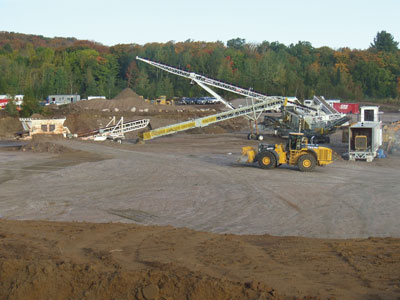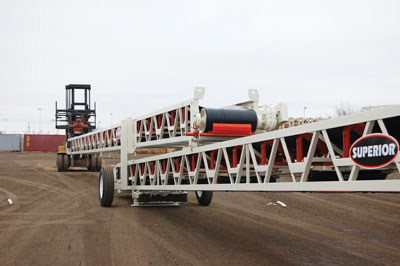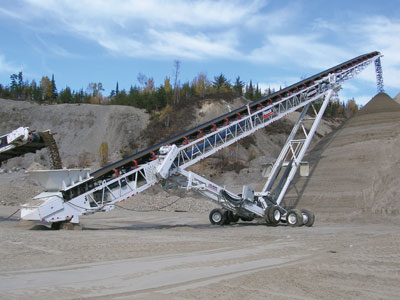
Features
Aggregates
Profiles
Mobility and Material Handling
A custom crushing operation streamlines its larger portable spreads with highly mobile conveyor
August 10, 2011 By Carol Wasson
Aggregate Processing Services Ltd. runs 10 portable crushing spreads and
five portable washing plants from site to site throughout Ontario.
Aggregate Processing Services Ltd. runs 10 portable crushing spreads and five portable washing plants from site to site throughout Ontario. As a custom crushing operation, the company processes high quality concrete and asphalt aggregates, as well as recycled materials for municipalities and private contractors, and for its sister company, Preston Sand & Gravel, which is a division of E & E Seegmiller, a Kitchener, Ont.-based company with full-service expertise in heavy civil, commercial, land development, municipal infrastructure and airport construction.
 |
|
| Seegmiller’s new portable equipment has helped to decrease setup time by 50%.
|
Blaine Bell, operations manager for Aggregate Processing Services, stresses the importance of ongoing upgrades to increase the mobility of material handling systems – particularly in applications that demand larger portable crushing spreads. He explains that as various crushing spreads expand into large primary jaw, and secondary and tertiary cone and screen combinations, it becomes imperative that the increasing numbers of transfer and stockpiling conveyors needed to serve these larger plant configurations be as mobile as possible to minimize time in setup and teardown. “Any conveyor will transfer material, but mobility is the key to our portable operations. If you have six or more conveyors and each takes over an hour of labour after relocation, then you’re losing valuable production time. The new flexible conveyor systems in our fleet go from transport to working mode in a matter of minutes,” says Bell, who adds that a large portion of his conveyor fleet are systems manufactured by Superior Industries of Morris, Minn.
Bell and his team acquired the new conveyor units from ELRUS Aggregate Systems, a Superior Industries dealer who specializes in portable equipment. Bell says that the new material handling systems (nearly 30 different Superior Industries conveyors) are delivering solutions that include decreasing setup and teardown time by more than 50%; dramatically cutting fuel costs by minimizing or eliminating loader use; and increasing stockpile volumes by up to 30%.
On the Road
Currently, Aggregate Processing Systems maintains a large portable spread to crush more than a million tons of material needed for the four-laning of the Highway 11 corridor, a 17-kilometre stretch of bypass for the villages of South River and Sundridge in northern Ontario. The project requires more than 200,000 tons of hot asphalt and enough washed rock to line every drainage ditch and embankment. “Our 3546 jaw feeds a gyratory cone followed by a 6 ft. x 20 ft. screen. An additional cone feeds another 6 ft. x 20 ft. screen as well as a 7 ft. x 20 ft. finishing screen,” says Bell.
 |
|
| Rollers move Superior’s Slide-Pac conveyors to and from setup in 10 minutes or less. |
At the South River processing site, Superior Slide-Pac Conveyors are used to transfer material from one screen to another, and out to the finished product stacking conveyors. Available in packages of 60- or 80-foot conveyors for a total of up to 240-feet in one load, the system is built with high efficiency rollers at the head end of each of the top conveyors for high-speed transition between transport and operating-ready positions. This allows users to safely slide one conveyor from the other until the set of three is set up in less than a 10-minute time frame. The slide-off method reduces the hazards involved in lifting heavy equipment; and a heavy-duty locking system fastens the conveyors together during transportation. “When we had used conventional stackable conveyors, we had to use either an excavator or a crane to take off the top conveyor,” Bell says. “It would be dangerous to use a loader. You could do it but it would not have been safe. Plus, every time you would pick up the conveyor, there was the chance of bending or damaging it. With the Slide-Pac conveyors we avoid these issues and can operate with speed and with safety,” he adds, noting that on other sites, the operation uses Slide-Pac conveyors in a transfer line to take finished product to feed a Superior TeleStacker Conveyor.
Bell says that one of the operation’s TeleStacker conveyors is soon being moved from a Sudbury, Ont., site to the South River site to stockpile road base material. “With a traditional stacking conveyor you get a lot of segregation, which leads to headaches and penalties. With the TeleStacker conveyors, we can create a fully desegregated stockpile and a consistent uniform gradation,” he says.
Stockpile Segregation
According to Superior engineers, a standard radial stacker can help minimize stockpile segregation, but it cannot overcome it. An automated telescoping radial stacker is the only solution to creating a fully desegregated stockpile. It stockpiles in very thin lifts or layers, with each layer consisting of a series of windrows of material. To accomplish this, the conveyor is in motion continuously – so automation is highly preferred over manual operation.
 |
|
| Superior’s Pinnacle conveyors are designed with setback axles for conveying more volume in less real estate.
|
“Also, the Superior TeleStacker conveyor is a heavier duty, better built unit than other telescoping radial stackers that we have in our fleet. And, its FD Series axle allows us to shift from transport to stockpiling mode in minutes,” Bell says.
Additionally, for stockpiling finished product where greater volume is desired, the company operates three Superior Pinnacle Conveyors in lengths from 80- to 100- to 125-foot units. Designed with a higher angle of incline (22 degrees versus an 18-degree angle on the standard stacker), Pinnacle conveyors have the capacity to stockpile up to 40% more material – or up to an estimated 10,000-ton capacity in one conical pile.
“At the South River site, we have an 80-ft. Pinnacle conveyor that is working on the top layer of the quarry, conveying 10-inch-minus material across the quarry wall to make a surge pile for the cone crushing circuit that is down below. It is a very tight setup. The unit is heavy-duty and well built, which it needs to be to accommodate that kind of a load. Like the TeleStacker conveyor, it is also equipped with an FD Series Axle. It only takes one crew member about 20 minutes to get this unit transport ready,” Bell says.
Lastly, Aggregate Processing operates several Superior Jump Conveyor packages. Stackable for cost-efficient transport, Bell says that the road-portable jump conveyors give them flexibility on any job site as each unit can be easily removed from the line one at a time as the stockpile grows. Also, the units are engineered with adjustable-height axle systems, which allow accurate feed into varying feed heights.
Not surprisingly, the ongoing fuel-cost crisis is causing operations like Aggregate Processing Services to take a much harder look at equipment and material transport costs, as well as haul truck and loader use. In fine tuning the portable fleet, mobility and material handling must go hand in hand to streamline material transfer and stockpiling processes – and to gain greater control over quality and costs per ton.
Carol Wasson is a freelance journalist based in Fort Wayne, Ind. She works for Superior Industries and other companies and produced this article for Aggregates & Roadbuilding.
Print this page